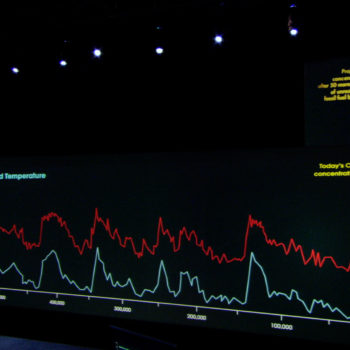Welcome to Earth Week: It’s been 50 years since the first Earth Day in 1970, which catalyzed a host of major environmental developments that we will explore today and throughout the week.
We will delve deep into old topics and stories and bring new light on how the half century since that very first Earth Day has transformed how we breathe, eat, shop, and live. We are breaking down each decade since 1970, and highlighting the major events that defined the environmental movement since that first celebration.
This is the 1970s: Watergate, Star Wars, heavyweight boxing, leisure suits, big hair, rock and roll. Add environmentalism to the list.
Richard Nixon is most well known for the Watergate scandal, but he was also one of America’s most environmentally influential presidents, and some of his accomplishments are noted below.
The first half of the 1970s was marked by governmental actions that had significant impacts both in America and abroad. The second half of the decade included a series of environmental disasters that raised widespread consciousness into the importance of protecting our planet.
Over the course of the week, we’ll highlight critical developments in each of the following four decades. Stay tuned as we fly across the world and catalog stories of promise and disappointment to honor 50 years since that first Earth Day in 1970.
Table of Contents
1970: First Earth Day
The first Earth Day in 1970 was primarily motivated by the Santa Barbara oil spill in 1969.
Wisconsin Senator Gaylord Nelson witnessed the damage firsthand and felt compelled to act. Nelson “realized that if he could infuse the energy of anti-war protests with an emerging public consciousness about air and water pollution, it would force environmental protection onto the national political agenda.”
Keep in mind that at the time, climate change had barely received any sort of popular notice. Other environmental issues (like air pollution) alone were enough to compel one of the largest activism movements in history.
Focusing on students, the first Earth Day was intentionally set for April 22 as it fell between spring break and final exams. That day, 20 million Americans took to the streets in a rare instance of largely bipartisan mass demonstrations. Senator Nelson said he wanted to “get a nationwide demonstration of concern for the environment so large that it would shake the political establishment out of its lethargy.”
Earth Day raised awareness of environmental issues to an unprecedented degree. 50 years later, the results have been mixed, but Earth Day continues as an annual reminder of how much work we have to do to protect and preserve Earth. Read here for recollections from Denis Hayes, an original Earth Day organizer who TIME Magazine dubbed “Mr. Earth Day” in 1999.
1970: Creation of EPA, NOAA
On July 9, 1970, the same year as the first Earth Day, President Nixon proposed an executive reorganization that centralized environmental-related concerns under one agency. That agency was the Environmental Protection Agency.
Fresh off the aforementioned Santa Barbara oil spill and the burning of the Cuyahoga River in 1969, a groundswell of environmental activism had finally translated into public policy.
Congress ratified Nixon’s order; in December 1970, Nixon signed it and the EPA began operations. The agency initially had little power beyond setting goals and standards. Over time, Congress granted the EPA greater regulatory authority.
The EPA employs over 14,000 people with a budget of ~$8 billion. Despite recent attempts (both internal and external) to undermine its authority, the agency still does important work protecting the environment by conducting environmental assessment, research, and education.
1970: Nat’l Enviro Policy Act
On January 1, 1970, the National Environmental Policy Act (aka NEPA) came into effect. Inspired by a decade of heightened environmental consciousness, NEPA transformed federal environmental policy.
The biggest impact of the NEPA was the requirement to prepare environmental assessments or impact statements for projects with federal funding that constitute “major federal actions significantly affecting the quality of the human environment.” While this provision has garnered controversy given the volume of lawsuits filed to stall large projects across the country, it undoubtedly gave ordinary citizens and other groups a uniquely easy and democratic ability to hold their government accountable.
The NEPA also inspired many states and over a hundred other countries to enact similar comprehensive environmental policies. All in all, as original Council of Environmental Quality chairman Russell Train put it a decade ago, “NEPA brought environment front and center to federal agencies.”
1972: Sierra Club v Morton
In the late 1960s, Disney won a US Forest Service bid to build a ski resort at Mineral King, a remote and secluded subalpine valley in the Sierra Nevada Mountains just a few hour’s drive outside of Los Angeles, California.
The Sierra Club initially backed Disney’s efforts but soon withdrew its support upon fully understanding Disney’s intended size and scale. The company planned to spend $35 million developing Mineral King; for perspective, it had only spent $17 million developing Disneyland just over a decade earlier.
The organization sued the federal government to curtail the resort’s development. The case went all the way to the Supreme Court, which ruled that the Sierra Club could not stop the project’s development since it had not alleged any injury.
Although the Sierra Club lost the battle, it won the war. After years of mounting concerns, the Mineral King dream formally died in 1978 when President Carter signed a bill that added Mineral King to Sequoia National Park.
Sierra Club v Morton is also famous for the scathing dissent of Justice Douglas in which he argued that natural resources deserve legal standing equivalent to personhood.
1972: First climate conference (Stockholm)
On June 5, 1972, governments convened in Stockholm to participate in the first major global conference on environmental issues. Focused on technological developments that threatened to permanently degrade the environment, conference participants had a lot to discuss, from urbanization to chemical pollution to atomic bomb testing. The presence of Minamata disaster survivors and Vietnam War veterans highlighted the narrative of “human technology running out of control” that truly gained worldwide attention with the publication of Silent Spring by Rachel Carson in 1962.
One simmering issue foreshadowed later tensions – the level of responsibility between developed and developing nations. A half century later, that debate remains unaddressed, with grave consequences.
The summit formally led to the creation of the UN Environmental Programme. Bigger picture, as summit attendee Jan-Gustav Strandenaes said, it “put environment on the political agenda” around the world.
The summit agreed upon a Declaration containing 26 principles concerning the environment and development. It ushered in periodic moments of global cooperation and unity, but ultimately, diplomacy repeatedly failed the global community in regard to climate change over the ensuing half century.
Indira Gandhi put things aptly at the conference: “It has been my perception that people who are at cross purposes with nature are cynical about mankind and ill at ease with themselves. Modern man must re-establish an unbroken link with nature and with life.”
1973: Endangered Species Act
In 1972, President Nixon called on Congress to pass comprehensive endangered species legislation. Bipartisan lawmaking resulted; President Nixon signed the Endangered Species Act into law in December 1973.
The ESA has been an unmitigated success, widely lauded as perhaps the strongest biodiversity protection legislation ever passed by any nation. 99% of species protected under the ESA have not gone extinct.
As of 2015, 90% of Americans support it, a rare example of bipartisan agreement. Animals from bald eagles to grizzly bears and gray wolves have recovered drastically in large part due to the ESA, which has stimulated the protection of millions of acres of critical habitats where many of these endangered species live.
The ESA is under threat with federal directives that would weaken some of its key provisions (particularly by prioritizing economic considerations). As a reminder, anthropogenic activities have induced a sixth mass extinction. Our global biodiversity has never been more imperiled.
1973: Arab oil embargo
The Arab oil embargo began in earnest in October 1973, when the Yom Kippur War prompted OPEC to proclaim an embargo targeted at Canada, Japan, the Netherlands, the United Kingdom, and the United States. A series of diplomatic and military escalations finally dissipated when the embargo ended in March 1974.
The oil shock produced many short and long term economic effects. The price of oil rose from ~$3 a barrel to $12 by March 1974, putting an end to decades of cheap energy. It led to a greater appetite for renewable energy and energy efficiency (perhaps known symbolically with the federal speed limit of 55 mph which lasted from 1974 to 1995).
Global politics changed as well. Among many other developments, NATO members sought to disassociate themselves from American foreign policy in the Middle East, hesitant to suffer from further punitive actions and other turmoil. Western Europe and Japan, who depended far more on Arab oil than the United States, shifted from pro-Israel to pro-Arab policies.
The events of 1973-1974 produced many downstream impacts beyond the scope of this article. Read more about them here.
1976: Seveso disaster
In July 1976, an explosion occurred in a reactor at a small chemical manufacturing plant just north of Milan, Italy. The accident unleashed a toxic cloud of dioxin – best known as a main ingredient in Agent Orange – into the atmosphere, contaminating the Seveso valley.
Within days, over 3,000 animals were found dead. To prevent the toxic substances from entering the food chain, over 80,000 animals were quickly slaughtered. No humans died but many developed skin problems and scientists later observed health problems tied to prenatal exposure to the dioxin.
The disaster led to stronger industrial safety regulations in Europe called the Seveso Directive. Seveso would soon be followed by more environmental calamities that sparked meaningful change, two of which you’ll see below.
1978: Love Island
From 1942 to 1953, the Hooker Chemical Company used the partially dug Love Canal in upstate New York as a waste dump. By the time the company sold its 16-acre hazardous waste landfill to the Niagara Falls School Board, it had dumped 21,000 tons of toxic chemicals (no, that’s not a typo). At least twelve of the released chemicals were known carcinogens.
Fast forward about a quarter century. A series of inexplicable illnesses, birth defects, and miscarriages gained attention. Wet winters had induced chemical leaching into the basements and yards of Love Canal residents, not to mention the playground of an elementary school built directly above the dump site.
In 1978, as local residents lobbied for government assistance, the unfolding disaster became too hard for the federal government to ignore. President Carter declared a federal emergency.
Love Island inspired the creation of a landmark federal program that you’ll read more about tomorrow as we highlight environmental developments from the 1980s.
1979: Three Mile Island
On March 28, 1979, a nuclear reactor partially melted at Three Mile Island near Harrisburg, Pennsylvania. Soon, radiation leaked and led to the most significant accident in U.S. commercial nuclear power history.
TMI officially caused no deaths. Nonetheless, an estimated two million people were exposed to radiation, and support for nuclear power declined sharply.
Three Mile Island marked a turning point in the history of nuclear power. In the decades leading up to the disaster, the number of reactors under construction increased almost every year. After TMI, construction slowly fell. Another major nuclear disaster in the 1980s that you can read about tomorrow put the nail in the coffin of nuclear power.
We’ll leave you with some food for thought: Did Three Mile Island inadvertently expedite climate change by substituting fossil fuels for nuclear power?
That’s it for the Earth Day 1970 edition. Until tomorrow.












No Comments